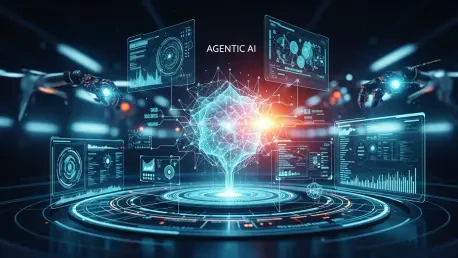Picture a marketing team buried under an avalanche of data, juggling disconnected tools, and racing against time to deliver personalized campaigns—only to fall short due to manual bottlenecks. Now, imagine a system that not only predicts these challenges but acts on them, autonomously optimizing customer journeys and freeing marketers to focus on strategy. This is no longer a distant dream but a reality powered by agentic AI, a technology that’s transforming the marketing technology (martech) stack into a dynamic, self-managing ecosystem. As of 2025, this shift is reshaping how brands engage with customers and how marketing teams operate, promising unprecedented efficiency and impact.
The significance of agentic AI lies in its ability to move beyond traditional automation. Unlike earlier tools that required constant human input, this technology operates independently, executing complex tasks, learning from interactions, and adapting in real time. It’s not just about saving time; it’s about revolutionizing the role of marketers and unlocking value across the customer lifecycle. With data silos crumbling and personalization scaling effortlessly, agentic AI stands as a game-changer for organizations striving to stay competitive in a hyper-connected, data-driven landscape.
What If Marketing Tools Could Think Independently?
Envision a typical campaign rollout where a marketer spends hours manually adjusting ad spend across platforms, analyzing disjointed reports, and tweaking email sequences based on gut instinct. The process is draining, error-prone, and often outdated by the time it’s complete. Agentic AI flips this scenario on its head by embedding intelligence into the martech stack, enabling tools to anticipate trends, adjust budgets dynamically, and even suggest content variations without human prompts.
This isn’t mere automation but a proactive partnership. An AI agent might detect a dip in engagement on a social channel, instantly reroute resources to a higher-performing platform, and update messaging based on real-time audience behavior. Such autonomy reduces the burden of repetitive tasks, allowing teams to focus on creative ideation and long-term vision while the AI handles execution with precision.
The implications are staggering for scalability. Where manual efforts once limited campaign reach, agentic AI empowers brands to manage thousands of customer interactions simultaneously, each tailored to individual preferences. This leap forward hints at a future where marketing isn’t just reactive but predictive, driven by systems that think and act with a level of agility humans alone cannot match.
Why Agentic AI Is Essential for Marketing Innovation
Today’s martech landscape is riddled with challenges—fragmented tools, isolated data pools, and the relentless demand for hyper-personalized experiences. Marketers face mounting pressure to deliver results faster while grappling with an explosion of customer data that’s often trapped in silos. Agentic AI emerges as a critical solution, addressing these pain points by unifying systems and enabling real-time adaptability.
The urgency for this technology is underscored by current industry trends. Studies reveal that disconnected systems cost businesses up to 30% of their revenue due to inefficiencies and missed opportunities. As customer expectations evolve toward seamless, contextual interactions, brands without integrated, intelligent solutions risk falling behind in a fiercely competitive market.
Agentic AI offers a lifeline by not only streamlining operations but also redefining what’s possible. It transforms the martech stack into a cohesive network where data flows freely, insights are actionable instantly, and customer touchpoints are consistently relevant. For marketing leaders, embracing this innovation isn’t optional—it’s a strategic imperative to maintain relevance and drive growth.
How Agentic AI Is Transforming Martech Capabilities
Agentic AI reshapes the martech stack through several distinct mechanisms, each amplifying efficiency and impact. One key area is autonomous workflow orchestration, where AI agents connect disparate tools and data sources to optimize campaigns on the fly. For instance, during a product launch, an AI might adjust email send times and social ad targeting based on live engagement metrics, ensuring maximum reach without manual oversight.
Another critical transformation is the elimination of data silos. By integrating marketing, sales, and customer success platforms, agentic AI ensures seamless information exchange, reducing friction and enhancing decision-making. Research indicates that organizations with siloed systems spend 20% more on redundant processes—a cost that AI-driven integration can slash by fostering a unified data environment.
Personalization at scale rounds out these advancements. With access to clean, connected data, AI agents craft tailored experiences for every customer, from initial ads to post-purchase follow-ups. A notable case study involves a retail brand that saw a 75% increase in engagement after deploying AI to customize email content based on browsing history, proving that agentic AI can turn data into a powerful driver of loyalty and revenue.
Expert Perspectives on Agentic AI’s Game-Changing Role
Industry voices add weight to the promise of agentic AI, highlighting its potential to redefine marketing workflows. A prominent tech analyst recently noted, “Agentic AI isn’t just automating tasks; it’s enabling a strategic pivot where marketers become architects of customer experience rather than executors of mundane processes.” This sentiment reflects a growing consensus that AI amplifies human capability rather than replacing it.
Research backs these insights, with findings showing that companies using AI-driven automation in marketing report productivity gains of up to 40%. Consider a hypothetical scenario of a mid-sized firm transitioning from manual campaign tracking to AI oversight. The team, once bogged down by data entry, now analyzes AI-generated insights to refine messaging, illustrating a shift toward higher-value work while maintaining control over outcomes.
Concerns about job displacement also surface in discussions, but experts counter with a balanced view. The emphasis lies on collaboration—AI handles repetitive grunt work, freeing marketers to innovate and strategize. This human-AI synergy is poised to create new roles focused on guiding technology, ensuring that the evolution enhances rather than diminishes the workforce.
Preparing the Martech Stack for Agentic AI Integration
Adopting agentic AI requires deliberate preparation to maximize its benefits within the martech ecosystem. A foundational step is integrating systems for seamless data flow, which means assessing current tools and prioritizing interoperable platforms. Marketing leaders should aim to dismantle silos by adopting solutions that enable cross-channel connectivity, ensuring AI agents operate with a holistic view of customer interactions.
Data quality and governance form another crucial pillar. Establishing modern data architectures and strict policies guarantees that AI agents process accurate, relevant inputs, avoiding costly errors. Alongside this, upskilling teams is essential—training programs should focus on strategic oversight, equipping marketers to monitor AI performance and refine its direction rather than execute tasks manually.
Finally, continuous evaluation is key to success. Setting business-aligned KPIs allows organizations to track AI effectiveness, while tools for monitoring engagement and conversion rates help fine-tune outputs. By adopting these actionable steps, marketing operations can harness agentic AI’s full potential, turning technological promise into measurable results and sustained competitive advantage.
Looking back, the journey of agentic AI’s integration into the martech stack revealed both transformative opportunities and significant hurdles. Teams that tackled data silos head-on and invested in training saw remarkable gains in efficiency and customer satisfaction. Those who hesitated often struggled with fragmented systems, underscoring the need for proactive adaptation. Moving forward, the focus shifted toward refining AI governance and fostering a culture of innovation, ensuring that marketers could leverage this technology to not only meet but exceed evolving customer expectations.









